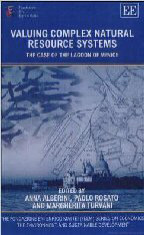Valuing Complex Natural Resource Systems : the Case of the Lagoon of Venice

01.03.2006
Anna Alberini, Paolo Rosato, Margherita Turvani
Edward Elgar, Series on Economics and the Environment
In complex natural resource systems, modifications or disruptions tend
to affect many and diverse components of the ecological system,
settlements and groups of people. This book uses the Lagoon of Venice – a
unique natural resource, wildlife habitat, centre of cultural heritage
and recreational site – as an example of one such system that has been
heavily affected by human activities, including the harvesting of
natural resources and industrial production. The contributors explore
the Lagoon’s potential for regeneration, examining public policies
currently under consideration. The aim of these policies is to restore
island coastlines and marshes, fish stocks, habitat and environmental
quality, defend morphology and landscape through the strict control of
fishing practices, and to protect the islands from high tides.
Contributors: A. Alberini, M. Breil, A. De Blaeij, E.
Defrancesco, A. Fassio, C. Giupponi, A. Longo, P.A.L.D. Nunes, P.
Rosato, L. Rossetto, S. Tonin, F. Trombetta, M. Turvani, V. Zanatta
In complex natural resource systems, modifications or disruptions tend to affect many and diverse components of the ecological system, settlements and groups of people. This book uses the Lagoon of Venice – a unique natural resource, wildlife habitat, centre of cultural heritage and recreational site – as an example of one such system that has been heavily affected by human activities, including the harvesting of natural resources and industrial production. The contributors explore the Lagoon’s potential for regeneration, examining public policies currently under consideration. The aim of these policies is to restore island coastlines and marshes, fish stocks, habitat and environmental quality, defend morphology and landscape through the strict control of fishing practices, and to protect the islands from high tides.
Contributors: A. Alberini, M. Breil, A. De Blaeij, E. Defrancesco, A. Fassio, C. Giupponi, A. Longo, P. A. L. D. Nunes, P. Rosato, L. Rossetto, S. Tonin, F. Trombetta, M. Turvani, V. Zanatta
